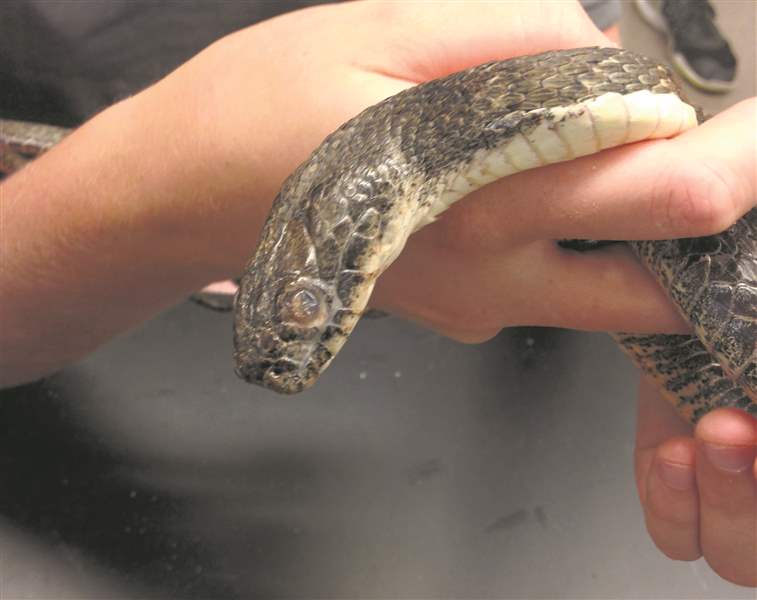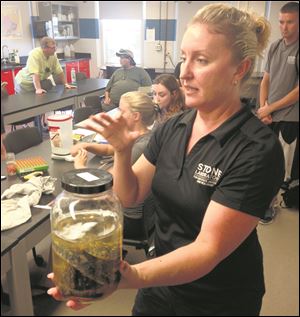
Fungal disease threatens Lake Erie water snakes
9/11/2017

Sarah Bailey and closeup of a sick, lethargic Lake Erie water snake.
THE BLADE/TOM HENRY
Buy This Image
GIBRALTAR ISLAND, Ohio — Just a few years ago, the once-threatened Lake Erie water snake defied the odds and became a poster child for species recovery.
Now, it faces a new foe: snake fungal disease, a condition typically characterized by scabs or crusty scales, premature separation of a snake’s outermost skin layer, white opaque cloudiness of the eyes, thickening of the skin, swelling of the face, skin ulcers, lesions, and other problems.
While the disease appears unlikely to throw those snakes back on the threatened or endangered species list, the fungus certainly has to potential to sicken them and slow down their progress.
Snake fungal disease is not limited to the Lake Erie water snake: According to the U.S. Geological Survey, it is emerging among several groups of wild snakes in the East, South, and Midwest.
VIDEO: Kristin Stanford, Ohio Sea Grant and OSU Stone Lab researcher, on the Lake Erie snake

Sarah Bailey and closeup of a sick, lethargic Lake Erie water snake.
Though believed to be more widespread than documented, the suspected fungal pathogen associated with skin lesions has been found in nine states: Ohio, Illinois, Florida, Massachusetts, Minnesota, New Jersey, New York, Tennessee, and Wisconsin.
The Lake Erie water snake is found only on the Lake Erie islands or in water near them.
They’re a lot like us: Harmless when left alone; ornery when provoked.
During a recent gathering with journalists at Ohio State University’s Stone Laboratory on Gibraltar Island, a tiny research island OSU owns near Put-in-Bay, Ohio, Sea Grant and OSU Stone Lab snake researcher Kristin Stanford said she is hopeful the fungus won’t hurt Lake Erie water snake populations in the long term, but is worried what might happen if the disease intensifies.
“Pathologically, what it’s doing inside to cause death we just don’t know,” Ms. Stanford said, adding it is as mysterious as the dreaded white nose syndrome which has killed millions of bats.
Several Lake Erie water snakes brought into Stone Laboratory have died within a day or two, she said.
“It’s concerning because you put forth all of this effort to achieve recovery, and now this happens,” Ms. Stanford said.
Researchers acknowledge, though, that the Lake Erie water snake might have been living with snake fungal disease to some degree while its recovery was in progress.
The first known case of the disease presented itself in a sick Lake Erie water snake in 2009, four years before the U.S. Fish and Wildlife Service put out a nationwide bulletin telling people to be on the lookout for symptoms among snakes in general.
But even as far back as the 1980s, snake researchers noticed something they called “hibernation blisters,” Ms. Stanford said. It’s possible that might have been an early warning sign of the disease emerging, but hard to tell, she said.
VIDEO: Sarah Bailey holding a sick, lethargic Lake Erie water snake
“It’s not abnormal to look bad after seven months of hibernation,” Ms. Stanford said.

Kristin Stanford, Ohio Sea Grant and OSU Stone Laboratory snake researcher, with a dead Lake Erie water snake in a jar.
A treatment for the disease shows promise, although it may be impractical to apply beyond selected groups of any snake species.
“I’m hoping it’s not affecting long-term population trends,” Ms. Stanford said. “It is still a concern. We don’t know how it’s functioning on a larger scale in the snake population.”
Sarah Bailey, a University of Virginia graduate assisting Ms. Stanford at Stone Laboratory, said she has seen several cases of Lake Erie water snakes with white opaque cloudiness of the eyes, including one she examined while the group of visiting journalists was there.
“A lot [of the impacted Lake Erie water snakes] go blind,” Ms. Bailey said.
Ms. Bailey demonstrated how she and other researchers inject a device called a “pit tag” into some healthy water snakes they capture. It’s a microchip about the size of a grain of rice, each with a unique letter code. That allows researchers to scan them like bar codes on supermarket products, retrieving information that helps them track snake distribution and learn more about their habits.
Lake Erie water snakes were classified as a federally threatened species from Aug. 30, 1999, to Aug. 16, 2011, according to the U.S. Fish and Wildlife Service.
Only 1,300 were believed to exist in 1984. About 1,500 to 2,000 existed when the snakes were formally listed as endangered in 1999.
Today, the population is estimated to be between 10,000 to 12,000, a figure that has stayed relatively stable the last six years. Their diet is now 90 percent round gobies, an exotic from Eastern Europe that has established strong populations in Lake Erie, even with once-endangered birds such as cormorants feeding on them too.
VIDEO: Sarah Bailey and Emma Scott on being bitten by the snake
Ms. Stanford attributes their demise to anxiety people have about snakes in general.
As the Lake Erie islands were becoming developed, people did virtually anything to kill snakes that crossed their paths.
They would dig them up during hibernation, pour gasoline on them and set fire to nests of them.
They used them for target practice. Many cut their heads off with shovels.
“Pretty much everything and anything, people were going out of their way to kill them,” Ms. Stanford said. “There are a lot of people out there who just don't like snakes.”
She called the mass killings of Lake Erie water snakes “one of the most well-reported instances of population decline through purposeful human persecution of any snake out there.”
The recovery was possible because of a well-orchestrated education and outreach campaign spearheaded by Ms. Stanford, who for years has been affectionately referred to as the “Island Snake Lady.”

Sarah Bailey, 22, a University of Virginia graduate studying snakes, implants a tracking device into a water snake. She said she has seen several snakes with white cloudiness of the eyes.
She carried on an outreach campaign that had begun years earlier by the U.S. Fish and Wildlife Service and one of her mentors, Richard King, a Northern Illinois University researcher. But her presence on cable TV, in the emerging social media networking, and via Old School forms of communication, such as fliers, public service announcements, and community speaking events, proved to be popular.
So did her simple slogan that appeared on signs, in pamphlets, and on bumper stickers everywhere: Respect the snake.
Lake Erie water snakes are nonvenomous, but they bite.
Ms. Stanford, Ms. Bailey, and other Stone Lab researchers — for some reason, snake research has become popular among women in recent years — laugh about the frequency of their bite wounds, and show them off like high school kids show off their football bruises.
They said wounds typically heal within two days. But for that split-second that fangs are clenched on their forearms and legs, it feels like a cluster of tiny needles.
“It doesn’t feel great. But after you've worked with them for a while, you get used to it,” Ms. Stanford said. “When you get bit, it's like getting a bunch of pin pricks in one area ...You do bleed a lot. It's like a scratch. You go to the lake and wash it off.”
Ironically, Ms. Stanford’s willingness to get bitten for the sake of research contributed heavily toward the Lake Erie water snake’s impressive recovery.
Starting in 2002, she began leading an annual two-week snake census in which as many as 60 scientists and volunteers scour the islands to catch, measure, tag, and weigh snakes.
But her big break came in 2006, when she was featured with television personality Mike Rowe on the Discovery Channel’s Dirty Jobs reality TV show. That helped her get the irritable-yet-lovable Lake Erie water snake into the national limelight.
The episode has lived on through the magic of YouTube. Audiences were entertained watching the snakes unleash foul-smelling feces and musk on the two humans and regurgitate partially digested fish.
The Lake Erie water snake’s comeback story has gained international attention, in large part because that sort of thing doesn’t happen as often as people might believe.
When the snake was taken off the endangered species list in 2011, it was only the 23rd species to have rebounded enough for delisting, according to the U.S. Fish and Wildlife Service.
At the time, then-U.S. Department of Interior Secretary Ken Salazar issued a statement that said the Lake Erie water snake “joins species such as the bald eagle, the American alligator, and the peregrine falcon that have rebounded from the threat of extinction and no longer require the protection of the Endangered Species Act.”
About 300 acres of inland habitat and 11 miles of shoreline have been protected to help aid the snake’s recovery.
Contact Tom Henry at thenry@theblade.com, 419-724-6079, or via Twitter @ecowriterohio.